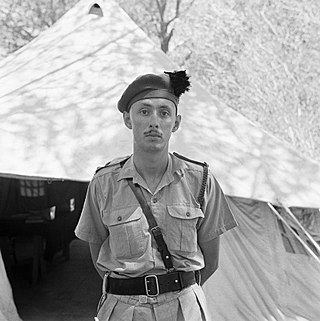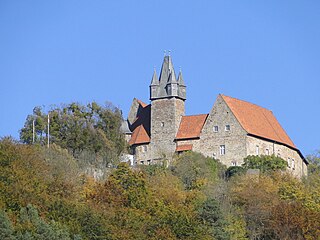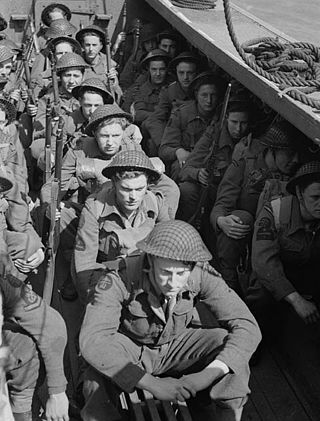
The Commandos, also known as the British Commandos, were formed during the Second World War in June 1940, following a request from Winston Churchill, for special forces that could carry out raids against German-occupied Europe. Initially drawn from within the British Army from soldiers who volunteered for the Special Service Brigade, the Commandos' ranks would eventually be filled by members of all branches of the British Armed Forces and a number of foreign volunteers from German-occupied countries. By the end of the war 25,000 men had passed through the Commando course at Achnacarry. This total includes not only the British volunteers, but volunteers from Greece, France, Belgium, Netherlands, Canada, Norway and Poland. The United States Army Rangers and US Marine Corps Raiders, Portuguese Fuzileiros Portuguese Marine Corps were modelled on the Commandos.
Layforce was an ad hoc military formation of the British Army consisting of a number of commando units during the Second World War. Formed in February 1941 under the command of Colonel Robert Laycock, after whom the force was named, it consisted of approximately 2,000 men and served in the Middle Eastern theatre of operations. Initially tasked with conducting raiding operations to disrupt Axis lines of communication in the Mediterranean it was planned that they would take part in operations to capture the Greek island of Rhodes.

Hon. Nathaniel Charles Rothschild was an English banker and entomologist and a member of the Rothschild family. He is remembered for The Rothschild List, a list he made in 1915 of 284 sites across Britain that he considered suitable for nature reserves.

Dame Miriam Louisa Rothschild was a British natural scientist and author with contributions to zoology, entomology, and botany.

Lieutenant Colonel Geoffrey Charles Tasker Keyes, was a British Army officer of the Second World War and a recipient of the Victoria Cross, the highest award that can be made to British and Commonwealth forces for gallantry in the face of the enemy. At the time he was the youngest acting lieutenant colonel in the British Army.

Sir Lionel Frederick Heald, was a British barrister and Conservative Party politician.
The Hungary men's national tennis team represents Hungary in Davis Cup tennis competition and are governed by the Hungarian Tennis Association.

Captain Michael Clive Burn, MC was an English journalist, commando, writer and poet.

Colonel David de Crespigny Smiley, was a British special forces and intelligence officer. He fought in the Second World War in Palestine, Iraq, Persia, Syria, the Western Desert and with Special Operations Executive (SOE) in Albania and Thailand.

Operation Flipper was a British commando raid during the Second World War, mainly by men from No. 11 (Scottish) Commando. The operation included an attack on the headquarters of Erwin Rommel, the commander of Panzergruppe Afrika in North Africa. It was timed for the night of 17/18 November 1941, just before the start of Operation Crusader. The operation failed as Rommel had left the target house weeks earlier and all but two of the commandos who landed were killed or captured. One member of the Special Boat Section team, who had secured the beach for the commando party, also escaped.
No. 11 (Scottish) Commando was a battalion-sized commando unit of the British Army during the Second World War. Formed in Scotland, members of No. 11 (Scottish) Commando adopted the Tam o'shanter as their official headdress.

Oflag IX-A was a World War II German prisoner-of-war camp located in Spangenberg Castle in the small town of Spangenberg in northeastern Hesse, Germany.
Raymond Couraud, was a French soldier and gangster, who through his World War II military exploits became a highly decorated member of the French-section of the British Army's Special Air Service.

Ashton Wold is a 54.0-hectare (133-acre) biological Site of Special Scientific Interest (SSSI) east of the market town Oundle in Northamptonshire.

No. 10 (Inter-Allied) Commando was a commando unit of the British Army during the Second World War, recruited largely from non-British personnel from German-occupied Europe. This unit was used to help co-ordinate attacks with other Allied forces.

The Commandos formed during the Second World War, following an order from the British Prime Minister Winston Churchill in June 1940 for a force that could carry out raids against German-occupied Europe. Churchill stated in a minute to General Ismay on 6 June 1940: "Enterprises must be prepared, with specially-trained troops of the hunter class, who can develop a reign of terror down these coasts, first of all on the "butcher and bolt" policy..." Commandos were all volunteers for special service and originally came from the British Army but volunteers would eventually come from all branches of the United Kingdom's armed forces and foreign volunteers from countries occupied by the Germans. These volunteers formed over 30 individual units and four assault brigades.

Operation Postmaster was a British special operation conducted on the Spanish island of Fernando Po, now known as Bioko, off West Africa in the Gulf of Guinea, during the Second World War. The mission was carried out by the Small Scale Raiding Force (SSRF) and the Special Operations Executive (SOE) in January 1942. Their objective was to board the Italian and German ships in the harbour and sail them to Lagos. The SSRF under the command of Major Gus March-Phillipps left Britain in August 1941 and sailed the Brixham trawler, Maid of Honour, to the Spanish colony.
Operation Tarbrush was the name of a series of British Commando raids during the Second World War, which took place in 1944. Members of No. 10 (Inter-Allied) Commando were responsible for this operation, which was intended to obtain photographs and other evidence of mines and other traps.

The Raid onBardia was an amphibious landing at the coastal town of Bardia in North Africa by British Commandos over the night of 19/20 April 1941 during the Second World War. The raid was carried out by No. 7 Commando, also known as A Battalion Layforce, together with a small detachment from the Royal Tank Regiment; the raiders were supported by five navy ships and a submarine. The raid destroyed an Italian artillery battery and a supply dump. It was deemed a success despite the loss of 71 men. The more lasting strategic effect of the raid was the diversion of a German armoured brigade from the front line to provide rear area security.
György Ligeti is a Hungarian indie musician, record producer, best known as the lead singer, songwriter, lyricist and guitarist of the indie rock band We Are Rockstars, and the disbanded The Puzzle. He is also the singer and guitarist of the Hungarian electro band, Žagar. He is not related to the avant-garde classical composer of the same name, György Ligeti (1923–2006).












